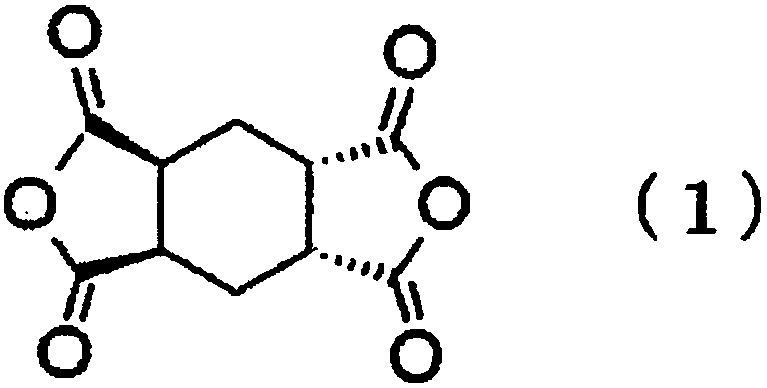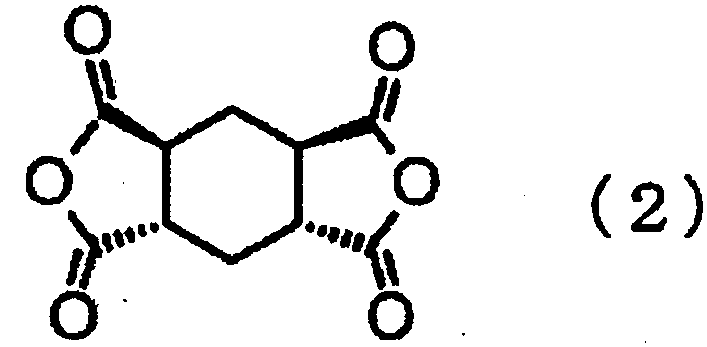Polyamide acid, polyimide, polyamide acid solution, polyimide laminate, flexible device substrate, and production methods thereof
A polyamic acid, polyimide technology, applied in chemical instruments and methods, sustainable manufacturing/processing, semiconductor/solid-state device components, etc., can solve problems such as damage to inorganic components, film bending, etc., and achieve low thermal expansion. Transparency and transparency, low birefringence effect
- Summary
- Abstract
- Description
- Claims
- Application Information
AI Technical Summary
Problems solved by technology
Method used
Image
Examples
Example Embodiment
[0156] (Example 1)
[0157]
[0158] In a 500 mL glass separable flask equipped with a stirrer with a stainless steel stirrer and a nitrogen inlet tube, 32.0 g of organosilicon sol NMP-ST-R2 (manufactured by Nissan Chemical Industry Co., Ltd., dispersion medium NMP, nano-silica content of 30 parts by weight, average particle size of 10-15nm) and 64.0g of NMP and stirred. After that, 9.6 g of a 1% NMP solution of 3-aminopropyltriethoxysilane (hereinafter sometimes referred to as γ-APS) was added, and the mixture was stirred at 25°C for 1 hour, thereby implementing nano-silica Interface processing. Add 9.7g of 3,5-diaminobenzoic acid (hereinafter sometimes referred to as 3,5-DABA) to this solution and stir to dissolve it, and then add 14.3g of 1R,2S,4S,5R-cyclohexane Alkyltetracarboxylic dianhydride (hereinafter sometimes referred to as PMDA-HS) was stirred for 12 hours, thereby obtaining a polyamic acid solution (reaction solution) containing nano-scale silica. Regarding the bl...
Example Embodiment
[0163] (Example 2)
[0164]
[0165] In a 500 mL glass separable flask equipped with a stirrer with a stainless steel stir bar and a nitrogen introduction tube, 32.0 g of the organosilica sol NMP-ST-R2 and 64.0 g of NMP were added and stirred. After that, 9.6 g of a 1% NMP solution of γ-APS was added, and the mixture was stirred at 25° C. for 1 hour, thereby performing interface treatment of nano-scale silica. Add 4.4g of 3,5-DABA to this solution and stir to dissolve it, then add 6.6g of 4,4'-diamino (N-phenylbenzamide) (hereinafter sometimes referred to as DABA) and stir 1 hour. After that, 13.0 g of PMDA-HS was added and stirred for 12 hours, thereby obtaining a polyamic acid solution (reaction solution) containing nano-sized silica. Regarding the blending ratio of each monomer, if all diamine components are 100 mol%, PMDA-HS is 100 mol%, 3,5-DABA is 50 mol%, and DABA is 50 mol%. In addition, relative to 100 mol% of polyamic acid Parts by weight, the content of nano-scale s...
Example Embodiment
[0168] (Example 3)
[0169]
[0170] In a 500 mL glass separable flask equipped with a stirrer with a stainless steel stir bar and a nitrogen introduction tube, 32.0 g of the organosilica sol NMP-ST-R2 and 64.0 g of NMP were added and stirred. After that, 9.6 g of a 1% NMP solution of γ-APS was added, and the mixture was stirred at 25° C. for 1 hour, thereby performing interface treatment of nano-scale silica. 1.7 g of 3,5-DABA was added to this solution and dissolved, and then 10.0 g of DABA was added and stirred for 1 hour. After that, 12.3 g of PMDA-HS was added and stirred for 12 hours, thereby obtaining a polyamic acid solution (reaction solution) containing nano-scale silica. Regarding the blending ratio of each monomer, if all diamine components are 100 mol%, PMDA-HS is 100 mol%, 3,5-DABA is 20 mol%, and DABA is 80 mol%. In addition, relative to 100 mol% of polyamic acid Parts by weight, the content of nano-scale silica is 40 parts by weight. Here, regarding the compoun...
PUM
 Login to view more
Login to view more Abstract
Description
Claims
Application Information
 Login to view more
Login to view more - R&D Engineer
- R&D Manager
- IP Professional
- Industry Leading Data Capabilities
- Powerful AI technology
- Patent DNA Extraction
Browse by: Latest US Patents, China's latest patents, Technical Efficacy Thesaurus, Application Domain, Technology Topic.
© 2024 PatSnap. All rights reserved.Legal|Privacy policy|Modern Slavery Act Transparency Statement|Sitemap



